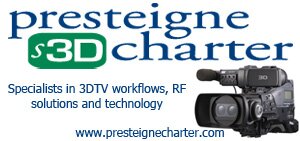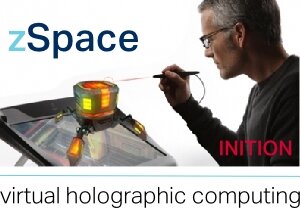Top Gun 3D details revealed
With new audiences expected to enjoy Tony Scott's 1986 action drama classic Top Gun in 3D, we speak to Legend3D Founder, Chief Creative Officer & Chief Technology Officer, Dr Barry Sandrew about the processes involved and what the original crew think about the final piece.

The restoration and conversion of Top Gun to 3D was completed several months ago and Tony Scott, together with Stefan Sonnenfeld of Company 3, completed the final color timing, officially wrapping the film on August 9th.
Audiences at last year’s IBC were very impressed with the short clip they were shown, with many saying it looked like Top Gun 3D had been shot with stereo cameras.
In a similar way to how a film shot in 3D is planned, Legend3D created a depth script for the entire movie before conversion commenced. Legend3D Founder, Chief Creative Officer & Chief Technology Officer, Dr Barry Sandrew told 3D Focus “Every shot in Top Gun has been carefully studied and strategically planned for stereo, not only in relation to its surrounding shots and within the context of its full sequence but also in relation to the rest of the story. The interactions between Maverick and Charlie, the close-up cockpit shots, the POV landscapes seen from the F14s, the barrel rolls during the dogfights, everything in the film has been designed in stereo so that it appears as it would if the audience was genuinely a part of the story. The stereo framing of each shot along with convergence placement and animated stereo parameters, are designed to guide the audience through the story, immersing them just as Tony Scott intended. The exquisite 3D detail in Top Gun as with all Legend3D films is often appreciated subliminally. From the fine character lines in an actor’s close up to the natural depth of eye highlights, nothing is ignored. There are no shortcuts.”
Top Gun was scanned at 6K under the supervision of Garrett Smith at Paramount. Legend3D restored the film at 4K and converted the film at 2K. Top Gun Director Tony Scott screened each reel as Legend3D completed them and was impressed. “He loved our work and only kicked back a few credit shots originally created optically that he didn’t feel played well in stereo so he had us recreate some of those credits" said Sandrew … "At the wrap of the film in early August, he made a special point to thank our creative team for all the amazing work, commenting that we created a whole new film experience for Top Gun.”
Tony Scott, Tom Cruise and original producer Jerry Bruckheimer screened the film together several months ago. In fact, Jerry was so happy with Top Gun in 3D, that after the screening he Tweeted “Just watched Top Gun for the first time since it was released in 86. Saw it with Tom and Tony in 3D, it was awesome.”

Jerry Bruckheimer with Tony Scott and Tom Cruise after Top Gun 3D screening
Tony Scott’s style often involved shots that are long in length and that included complex dolly moves. “In those shots, the audience has an opportunity to explore every aspect of what is going on within each shot. Consequently, the stereo has to be very comfortable to watch and conversion must be used to help direct the audience to in the manner that Tony intended” said Sandrew.
Once frowned upon, the process of 2D to 3D conversion is gaining more acceptance by audiences and movie-makers. When done right, it can be difficult to distinguish the difference between native and converted material. Most films shot with 3D cameras feature converted scenes, either for practical reasons on set or to fix errors produced by the rigs such as alignment issues. Approximately half of Transformers: Dark of the Moon 3D was converted by Legend3D and Dredd 3D (to be released in America September 21st) contained 84 converted shots; even Avatar featured many such scenes.
The debate will continue whether there is a future in filming with stereo rigs, as if 3D is considered a special effect, it seems more practical to apply it as a post process. However, others believe it will never be able to match the ‘true’ stereo of filming with rigs. In the meantime, it is likely a combination of both will continue according to Sandrew…
<
“Whether captured by camera rigs or converted, 3D created for feature films is an extremely complex visual effect. I believe camera rigs and conversion can and should co-exist. There are typically shots that cannot be handled with rigs and there are camera rig shots that simply did not work out for one reason or another. In the former case, we would do a straight conversion of 2D material. In the later case, we can take one good eye and convert the shot so that it can be seamlessly edited into the film. We’ve done conversions for both Pirates of the Caribbean: On Stranger Tides and The Amazing Spider-Man. Both films were shot in stereo, and both had some conversion needs as well as stereo fixes, which were handled by our StereoWorks Division. That said I believe there are many reasons to choose conversion over shooting with camera rigs. I believe conversion offers more creative control for the filmmaker. Conversion doesn’t limit what type of lens the director wants to use in a particular shot. Long lenses on 3D rigs tends to flatten out objects in the foreground. However, the same shot in 2D and subsequently converted will have proper volume and depth so that it will look natural. For visual effects-heavy films, conversion is often the preferred choice because it’s more efficient and is often of higher quality, particularly when the visual effects elements are available and can be used throughout the conversion process.”
What is for sure is that the conversion of back catalogue movies to 3D can be a very lucrative enterprise. Titanic 3D cost $18 million to convert and made many times that at the box office, enjoying huge success in China.
Legend 3D are currently working on other classic re-releases but cannot divulge the titles or the studios because of NDAs. However, they have told us that they fully expect re-releases to grow significantly over the next three years. Many will go directly to Blu-ray but a significant number of iconic classic blockbusters will continue to be re-released into theaters.
Independence Day will be re-released in 3D next summer and the entire Star Wars collection will be converted to 3D after a reasonably successful re-release of Star Wars: The Phantom Menace in 3D. There is no release date for Top Gun 3D as Paramount are still finalising their plans.
FREE WEEKLY 3D NEWS BULLETIN –



















